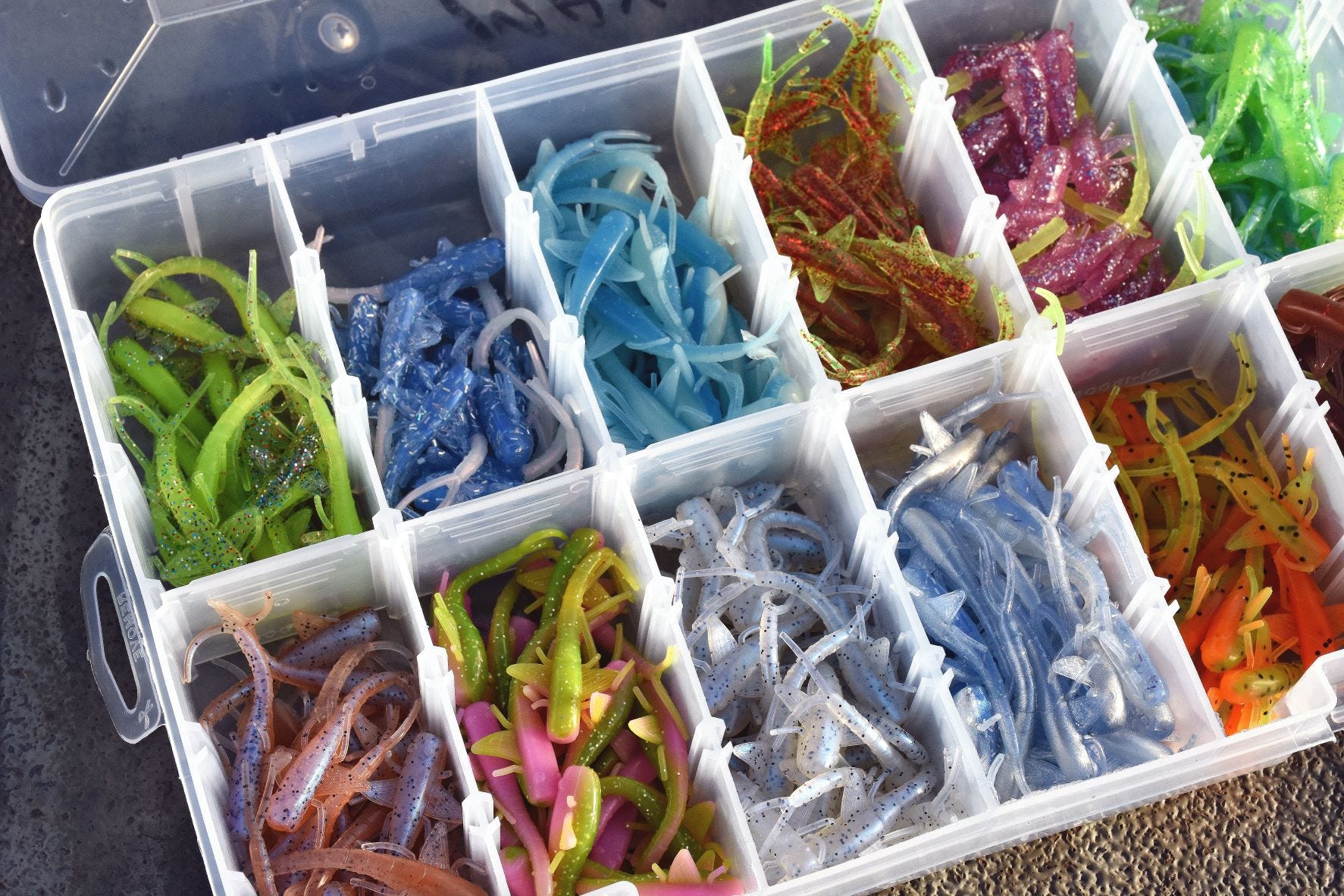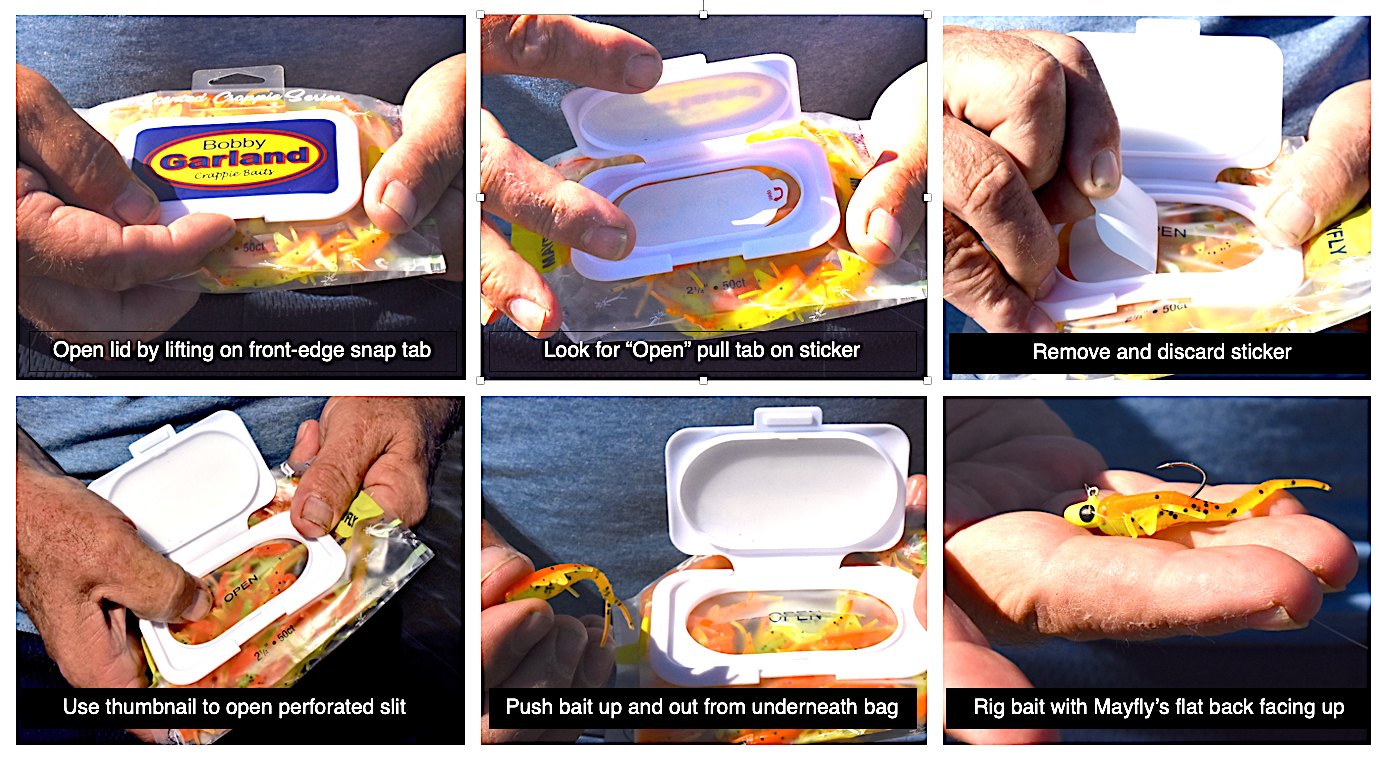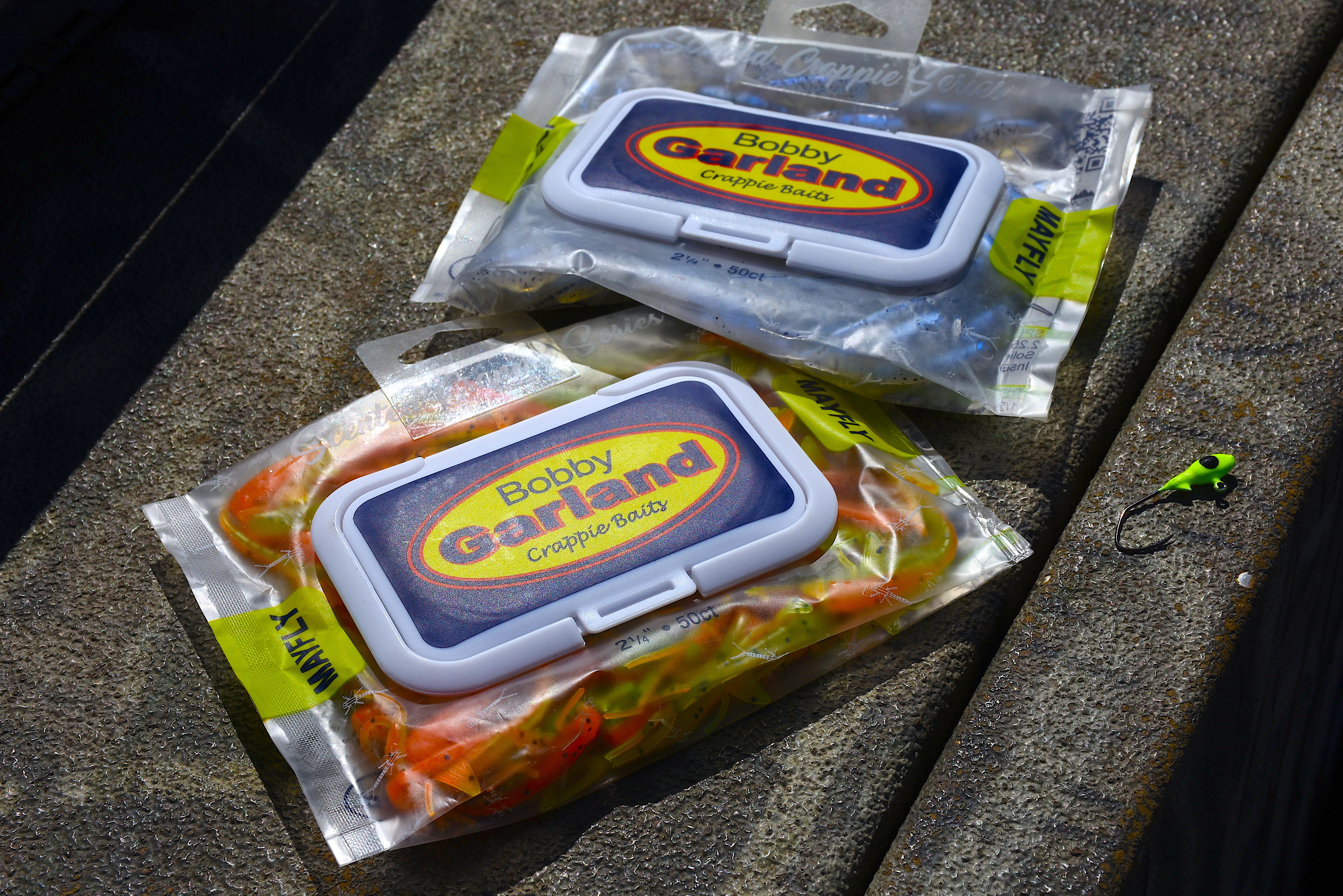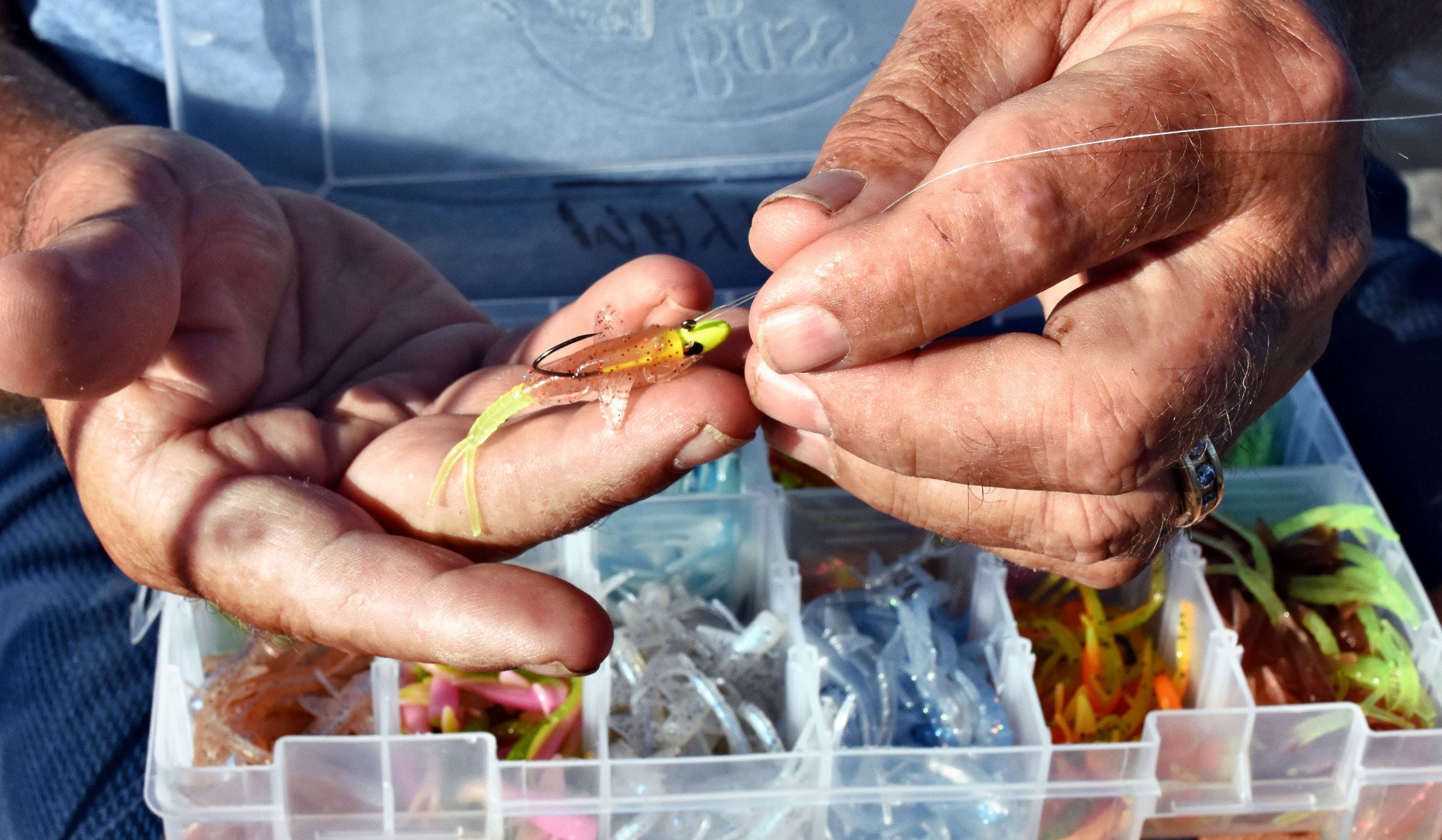- Jul 20, 2022
Bobby Garland Mayfly Hatch Is On
The Mayfly, a new crappie lure from Bobby Garland, effectively matches an aquatic insect but also can be used to suggest other crappie forage. Learn more about this innovative new bait.
Google “what do crappie eat,” and you’ll surely tire, reading through the seemingly endless results. Instead, let me summarize what pops up most: insects, crustaceans, minnows and shad. That science explains why Bobby Garland’s newest soft-plastic bait, the Mayfly, borrows a few traits from each of the crappie’s favored menu items in its innovative design.
By name alone, the Mayfly lure is clearly an imitation of the common aquatic insects found in lakes, streams and creeks throughout North America. Whether in the larval stage and under water or emerged as a winged adult Mayflies have legs, an elongated and segmented body, and two or three threadlike “tails” (officially called cerci). In either form, black and white crappie find Mayflies irresistible. Of the two crappie species, black crappie exhibit a special fondness for insects in their overall diets.
“Profile” has become the new buzzword in crappie fishing, thanks in large part to forward-facing sonar. The technology has opened anglers’ eyes through real-time viewing of what’s happening below in the interaction between crappie and lures in various situations and seeing the importance of a crappie lure’s profile.
The 2.25-inch Mayfly’s profile can pass as a larva, bug or baitfish. A single lure design with multiple personalities no doubt has advantages when it comes to trying to crack a crappie’s finicky side and getting the fish to bite.
The Mayfly’s distinctive silhouette caters to a crappie’s dependence on vision and sight for feeding proficiency. However, this bait appeals to other senses as well. The bait’s flexible appendages and tail produce vibrations that crappie can “hear.” And, since the lure comes packaged in a scent bath, the Mayfly also appeals to a fish’s senses of smell and taste.
Colors, too, can trigger bites, and the Mayfly is available in solids, laminates and head/tail combinations. The bait’s initial launch consists of 12 colors, including eight popular Bobby Garland colors, and four brand new ones. Here’s a look at all.
Colors


Solid (Entire bait is the same one color)
Monkey Milk – The brand’s top-selling Monkey Milk color is a semi-transparent pearlescent hue with blue highlights, and black flake scattered throughout.
Laminates (Two colors, one layered over a second color – back/belly)
Blue Ice – Blue Ice features a back that is a transparent light-colored sky blue with holographic string flake. The belly color is an opaque pearl white with no flake.
Electric Chicken – Electric Chicken features a bubblegum pink back with no flake. The belly is an opaque chartreuse color with silver flake.
Bluegrass – Bluegrass has a back that is an opaque light blue with blue flake. The belly is a mostly opaque chartreuse with silver flake.
Mo’ Glo Glow Worm (NEW!) – In the Glow Worm, the back borrows the glow-in-the-dark pale blue from Bobby Garland’s Blue Ghost color, but loads it with small holographic flake. Belly is the typical non-color glow hue.
Mo’ Glo Green Lantern – Green Lantern has a non-glow clear back with multi-colored bright flake in it, while the belly is a high glow-in-the-dark “cloudy” chartreuse.
Mayfly – Mayfly features a Monkey Milk back that is layered over a light pumpkinseed-colored belly with tiny red flake in it.
Cajun Cricket – Cajun Cricket is a semi-transparent orange back with black flake, and a semi-transparent chartreuse belly with black flake.
Chartreuse Red Glitter – Chartreuse Red Glitter is bright clear chartreuse with red flake in the back, over the same bright chartreuse in the belly but with no flake.
Body/Tail (Two colors, with body and tail differing)
White Ice (NEW!) – White Ice features a body with Bobby Garland’s Blue Ice color loaded with holographic string flake. The tail is Bobby Garland’s Glacier, which is an opaque pearl with light rosy-hue highlights and tiny blue flake.
Spring Fling (NEW!) – Spring Fling has a body that is bright pink cotton candy with silver and black flake, butted up against a mostly opaque pearl chartreuse tail.
Neon Nymph (NEW!) – Neon Nymph is a dark pumpkinseed body with red flake, next to a mostly opaque pearl chartreuse tail.
50-Count “Wet” Package


Also unique to the series is the Mayfly’s packaging, featuring a wet-wipes styles bag with a snap-close hinged lid. It was selected to contain this bait for three specific purposes: (1) to accommodate a liquid scent bath; (2) to provide plenty of roominess in protection of lure shape and appendages; (3) to allow for the high quantity of 50 baits.
The bag is comparable in size to the traditional Bobby Garland zip-style bag, measuring 6-inches long by 4.5-inches tall. However, the wet bag has pleated sides that expand to one-half inch wide, giving the package greater depth so the baits can move freely inside and not be crushed out of shape. Still, the bag is compact and can be easily stored flat to occupy minimal space in a tackle box, tackle bag, or boat compartment.
Under the hood of the hinged lid is a silicone gasket to help protect against leakage when the closure is firmly snapped shut. Opening the lid exposes the top of the bag underneath and provides access to the baits. You’ll first see an adhesive sticker covering the access point, which is a perforated, but still-closed slit, not a cut out. The sticker has an “open here” pull tab that allows for easy grasping and removal of it, and then you can properly dispose of the sticker.
Under the sticker, the perforation line has the word “OPEN” printed across it. Run your thumbnail across the perforation to open the slit and gain access to the baits. For bait removal best results, place one hand underneath the bag and use it to push baits upwards so that they slide up and out of the slit opening. This is a much better option versus using your fingers to “dig” baits out because it keeps the slit size intact as a minimal opening for the ultimate protection of scent and baits. The bag’s frosted exterior allows clear vision inside, making it easy to see and manipulate baits through the opening. The visibility also makes it easy to quickly see the color of Mayfly baits inside. Bait color is also indicated on the UPC label affixed to each bag’s backside.
Of course, Mayfly lures can be removed and placed in tackle or utility box compartments instead, but doing so takes them from their scent-soaking baths and, depending on how they are positioned, could potentially compromise bait “shape.”
Natural Scent Bath


The Mayfly scent is a light, natural fish oil. It serves both as a proven attractant to entice strikes and as a lubricant to allow the baits to move freely in the packaging. The unhampered movement aids in bait removal through the bag’s opening, and also helps protect the bait’s insect-style shape and appendages.
Rigging


As with all Bobby Garland crappie bait designs, the Mayfly is as versatile as are the crappie anglers who use crappie baits. The bait’s solid body firmly holds every style of jighead well, and the lure’s streamline body allows it to track true whether being reeled, trolled or jigged. Running straight makes the Mayfly a compatible option for all crappie fishing techniques, from dock shooting to spider rigging. It has been field tested across many parts of the country – in all seasons and waters, from cold to hot – and has consistently fooled crappie everywhere it has visited.
For traditional rigging as a single jig, the Mayfly matches perfectly with jigheads in sizes from 1/24- to 3/16-ounce.
The bait does have a distinguishable back and belly, with the back being quickly identified by its flat surface and having eyes sitting atop the lure’s head end; rig it with the back facing toward the sky. Do this by inserting the hook into the bait’s nose, running it along the body’s midline for a distance nearly equal that of the hook’s shaft length, then bringing the point up and out of the lure’s back.
Take the time to rig the bait perfectly straight on the hook. If it needs adjusting to accomplish straightness, simply back the bait off the shank until the point goes back inside the lure, and then bring it out again but in a different exit position that straightens the rig. This rigging presents the bait in a natural horizontal position that keeps the elongated body and spindly twin-tails dancing enticingly whether the angler is intentionally employing action or not.
As pointed out in the opening, the Mayfly’s profile carries traits from many of the creatures that crappie prey on most – insects, crustaceans, minnows and shad. That’s why we believe the Mayfly is the perfect all-around crappie bait. Proof is in the catching … try it!



